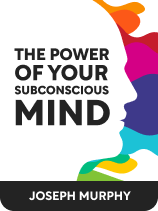

This article is an excerpt from the Shortform book guide to "The Power of Your Subconscious Mind" by Joseph Murphy. Shortform has the world's best summaries and analyses of books you should be reading.
Like this article? Sign up for a free trial here .
Do you often find yourself stuck in negative thinking patterns? What can you do to train your mind to think more positively?
According to Joseph Murphy, the author of The Power of Your Subconscious Mind, negative, self-sabotaging thoughts can block the flow of Universal Consciousness into your life. When this flow is blocked, you are more likely to attract negative experiences into your life.
In this article, we’ll explore specific methods you can use to reframe your thoughts for more positivity.
Joseph Murphy: How to Reframe Your Thoughts
In his book The Power of Your Subconscious Mind, Murphy suggests five methods you can use to reframe your thoughts and train your subconscious mind to create positive experiences in your life:
- Choose thoughts that make you feel happy.
- Identify with what you want.
- Create automatic behavior using conscious repetition.
- Visualize what you want.
- Relax your mind to reduce interference from your conscious mind.
Method 1: Choose Thoughts That Make You Feel Happy
Murphy believes that you need to focus on thinking only positive thoughts if you want your subconscious mind to create positive experiences. But how can you know whether your habitual conscious thoughts are positive or not? According to Murphy, you just need to judge how you feel. If you feel happy and you have positive expectations about your life, you’re thinking positive thoughts. On the other hand, if you don’t feel good about your life experiences, you’re thinking negative thoughts.
(Shortform note: Research backs up Murphy’s claim that your thoughts and emotions are inextricably linked and confirms that positive thoughts make you feel happy. However, sometimes, it’s not so easy to force yourself to think happy thoughts. Fortunately, there is a way to trick your brain into believing that you’re happy: smiling. Neuroscience research reveals that smiling spurs a chemical reaction in the brain that releases specific hormones including dopamine and serotonin. These hormones increase your happiness and reduce your stress levels. In short, smiling makes you feel happy. When you feel happy, you’re more inclined to think positive thoughts that continue to make you feel happy.)
Method 2: Identify With What You Want
To develop positive expectations, Murphy suggests that you think only about what you want to experience. Instead of worrying about how you’ll achieve something, focus on the end results and imagine the gratitude you’ll feel once you have it. This process will set a clear direction for your subconscious mind to move towards.
(Shortform note: Like Murphy, Wattles (The Science of Getting Rich), argues that you shouldn’t worry about how to achieve what you want. Instead, just expect everything to work out in your favor. Wattles suggests that imagining your desired end result and practicing gratitude in advance of receiving what you want not only sends a clear message to the universe, but it also keeps you from becoming dissatisfied with your current life experiences. This is because, when you imagine feeling grateful for something you don’t yet have, you feel positive regardless of what’s actually happening in your life. The more positive you feel, the more likely you are to adopt behaviors that move you closer to what you want.)
Murphy suggests that you use this method to improve your thinking about any area of your life:
Addictions
Imagine the freedom you’ll feel and all of the opportunities you’ll embrace once you’re free from your addiction. According to Murphy, the more you focus on the benefits of releasing your addiction, the less likely you’ll be to give in to your urges.
Love
Focus on your partner’s best qualities and take the time to offer praise. If you’re looking for a partner, Murphy suggests that you think about what type of person you want to be with, how you’ll spend your time together, and how this person will make you feel.
Problems
Trust that every problem comes with a solution and imagine how you’ll feel once you’ve figured it out. According to Murphy, Universal Consciousness has access to all of the answers—your positive expectation gives you access to these answers.
Relationships
Consider how you’d like other people to think about you. Now think about them in this way regardless of how they behave. For example, if you’d like people to treat you with more respect, then you need to think respectful thoughts about others. Murphy argues that people will intuitively pick up on your positive thoughts and, as a result, their behaviors toward you will improve.
Wealth
Decide on how you’ll enjoy spending the wealth you want. Murphy claims that imagining how comfortable you’ll feel with more money will prime your subconscious to create wealth.
Method 3: Create Automatic Behavior Using Conscious Repetition
Recall: Murphy argues that your subconscious mind learns from repetition. When you first try to change your habitual conscious thoughts, you’ll need to apply conscious effort to think positively. But, with repetition, your positive thoughts will eventually imprint upon your subconscious mind to form positive beliefs and outweigh any negative and outdated beliefs. As a result, your subconscious mind will influence you to think and behave in positive ways without conscious effort.
For example, if you have social anxiety, improve your self-confidence by repeatedly thinking kinder thoughts about yourself. Over time, you’ll replace your anxious thoughts with more compassionate thoughts. This will increase your self-confidence and allow you to enjoy socializing with others.
(Shortform note: While it’s true that repetition leads to automatic behavior, opinions vary on exactly how long it takes for your subconscious mind to become accustomed to your new thoughts. Research studies reveal that it can take between 18 and 254 days, or an average of 66 days, for habits to become automatic. The timeline depends on how consistently you practice your new habits—the more often you consciously practice thinking your chosen thoughts, the quicker your subconscious mind will align with these new thoughts.)
Method 4: Visualize What You Want
According to Murphy, when you visualize an image, you add weight to the impression your conscious thoughts form in your subconscious mind. This is because your subconscious mind can’t tell the difference between imagination and reality—it only knows that you’re thinking about something often enough to create a detailed picture in your mind. The more you dwell on this image, the more likely your subconscious is to accept this image as an instruction about what it should create.
| When Visualization Makes You Lose Interest in Your Goals While Murphy argues that visualization is an effective way to get Universal Consciousness to create your life experiences, research shows that visualization may negatively impact your subconscious mind when you apply it to your goals. In Ego Is the Enemy, Ryan Holiday claims that visualization can confuse your subconscious mind and create the opposite effect of what you want to achieve: When your mind believes that you’ve already achieved something, you feel that you’ve made progress despite not having taken any measurable steps toward achieving your goal. This feeling of progress feels good, but it’s based on a false sense of achievement that may cause you to lose sight of the actions you need to take to move forward. In fact, researchers examining the effects of visualization on goal achievement found that participants often lost the energy required to fulfill their goal because once they convinced themselves they’d already achieved the goal, they lost interest in trying to progress toward it. |
Method 5: Relax Your Mind to Reduce Interference From Your Conscious Mind
Murphy believes that your subconscious mind is more effective when you’re relaxed or asleep because you’re unable to use your conscious mind to think unproductive thoughts that contradict what you want.
When you’re awake and alert, you can’t help but think about and judge everything around you. According to Murphy, this is what your conscious mind is designed to do. Unfortunately, this creates problems for you when you’re trying to retrain your subconscious mind. This is because you can’t just change your habitual conscious thoughts and beliefs instantaneously—your mind needs time to get used to your new way of thinking. During this time, your conscious mind questions and contradicts the beliefs you want to change. This conflict between what you want to believe and what you do believe creates confusion for your subconscious mind because it’s not receiving clear instructions from your conscious mind.
For example, you want your subconscious to believe and expect that you’re confident about something. But, your conscious mind is so used to thinking of you as unconfident, that it questions your new belief and offers counterproductive thoughts and memories to rationalize why you should feel unconfident: “How can you feel confident when you failed so miserably the last time?”

———End of Preview———
Like what you just read? Read the rest of the world's best book summary and analysis of Joseph Murphy's "The Power of Your Subconscious Mind" at Shortform .
Here's what you'll find in our full The Power of Your Subconscious Mind summary :
- How your subconscious mind creates your life experiences
- How to improve your life experiences by using your conscious mind to influence your subconscious
- Why we're all designed to experience happiness






